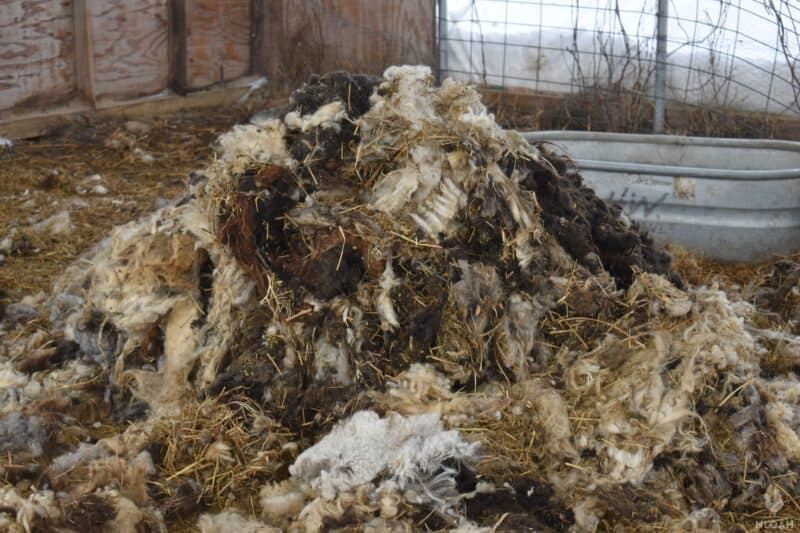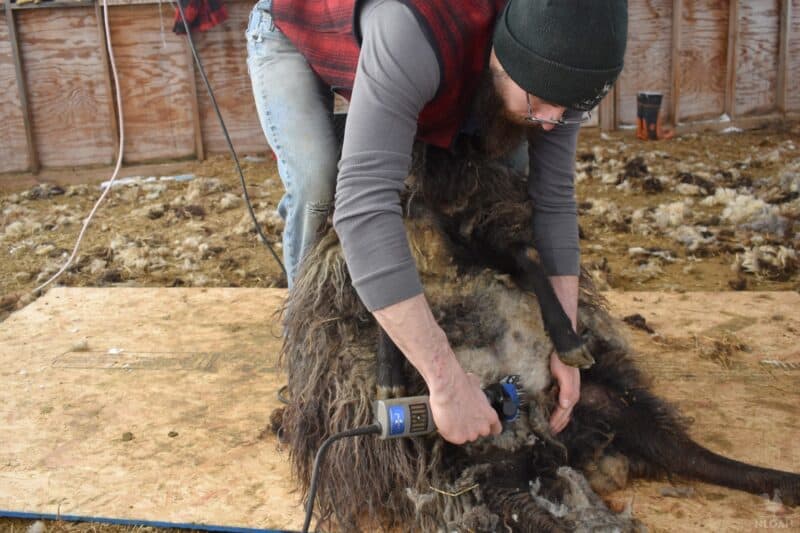If the first word that comes to your mind when you think of sheep is wool, you aren’t alone. Sheep are indeed the world’s most important wool-producing livestock species.

But what you might not know is it not all sheep actually produce wool. Even the ones that do, including the ones that are well-known for wool production, can produce a significantly varying amount of wool when fleeced.
So, just how many pounds of wool can you get from a sheep every year?
You can get anywhere from 2 to 30 pounds of wool from a sheep each and every year. There are many factors that impact wool production of individual sheep, including their overall health and breed, and the level of care they are given.
That’s quite a huge range when you think about it!
And when you consider that the wool economy is closely linked to overall production, you’d better believe that you’ll need to know exactly how much wool you can expect from your sheep and under what conditions.
In fact there’s a whole lot to consider, so if you’re thinking about getting sheep in order to harvest their wool, you should keep reading.
How Much Wool Does the Average Sheep Produce per Year?
This is another highly variable metric, but your average sheep will produce a lot less than the maximum of about 30 pounds of wool a year. There are plenty of sheep kept specifically for their wool that will yield between 7 and 10 pounds of wool a year.
Not All Sheep Produce Wool, but Most Do
Another thing to consider is that some sheep don’t produce any wool whatsoever! It’s true, even though wool is certainly synonymous with sheep generally.
Some sheep don’t produce wool that is economically viable you might say, in the case of wild species, but there are also domestic breeds that have hairinstead of traditional wool. This hair typically isn’t harvested for the use in textiles.
Some breeds that don’t produce wool include the Katahdin, St. Croix and Romanov sheep among others. That could be a terrible blunder if you invested in any of these breeds expecting a return of wool!
Wool Yield Depends on Many Factors
There isn’t just one factor you’ll be able to point to for determining how much wool you can expect from your flock or from any individual sheep.
There are several guidelines, or rules of thumb, that are generally reliable but you’ll have to look at them all together if you want to make an informed guess.
Breed and Genetics are a Huge Factor
Naturally, one of the single biggest influencing factors determining the yield of wool from a sheep is its genetics.
Like all domestic animals, there are various sheep breeds that were developed for specialized purposes, either relatively recently or over long centuries.
Some are bred specifically for wool production, producing either wool of superb quality or just producing a whole lot of it, sometimes both!
For instance, Merino sheep are widely known for the overall quality of their wool but they can also be quite prolific, with yields of up to 25 pounds or sometimes more every year.
Others that are known for producing large fleeces reliably include the Romney (18-22 lbs./yr), Lincoln (12 to 16 lbs./yr), Columbia (12 to 16 lbs./yr) and Targhee (10 to 12 lbs./yr).
Breeds that are known for producing excellent wool, but not a whole lot of comparatively, include the Blue-faced Leicester, and the Corriedale.
There are variations to be expected depending on the lineage of the sheep, too.
Dual-use or Meat Sheep Yield Much Less Wool
Another good rule of thumb and one that you can typically depend on is that sheep bred for meat production or as dual-use sheep for both meat and wool, or milk, well typically produce a lot less wool and sometimes wool of lesser quality compared to the aforementioned wool breeds above.
This is just a natural consequence of selective breeding over countless generations, and it does not mean that the sheep aren’t worthwhile for wool production or that they won’t be profitable; it’s just something to keep in mind if you want to maximize wool production for any purpose.
And there are exceptions too, with the aforementioned Corriedale and Targhee being very capable wool producers even though they are properly classified as dual-use breeds.

Rams Usually Produce More Wool than Ewes
As you might have expected, you can depend on rams producing larger, thicker and heavier fleeces compared to ewes, averaging anywhere from 10% to 15% heavier, all other things being equal. Part of this is because males are simply larger than females with a correspondingly greater volume of fleece. The other part is due to their biological differences.
In a certain line or breed you might notice that the females are generally as good as the males, or that certain males might be lackluster for their size, but this rule is dependable.
Lambs Produce Less than Adults
Another obvious factor, lambs produce a lot less wool than adults, all other things being equal! That’s because lambs are so much smaller than adults and because, even when they are almost entirely physically mature, they still aren’t completely developed…
Don’t expect a lamb to start producing sizable fleeces until they are at least a year old or a little bit older. On the other hand, lambs can produce wool of superior softness and quality which makes it highly desirable for certain industries and applications.
This is important to consider regarding profitability in spite of the greatly reduced yield associated with lambs.
The Care of the Sheep Makes a Difference, Too!
The level of care afforded to each and every individual sheep makes a difference in how much wool it will produce. Sound unbelievable? It’s true!
When sheep are cared for, sheared on a schedule, given plenty of food, and generally looked after they will produce more wool than they would otherwise.
Mistreated, filthy, matted wool and malnutrition will reduce the rate at which the wool grows and also the amount of wool that can be salvaged after shearing.
Other mishaps like illness and injury can impede the growth of wool, or necessitate the premature sharing of the wool in order to address problems.
Even if the wool is not lost, staining from scours or blood can result in subpar wool or wool that must be discarded after shearing.
Just like every other livestock species out there, happy, cared for and pampered sheep are more productive sheep, even concerning something they have no control over like their wool!
The better you can make the lives of your sheep, the more wool you’ll get when it is time to harvest.
Some Gross Yield is Lost During Shearing and Processing
Something else to remember is that the gross weight of the wool is not necessarily the net amount of wool that you’ll be able to sell or make use of.
This is because the follow-up cleaning and processing of the wool means that a certain amount will, almost invariably, be lost.
Likewise, inexperienced, sloppy or hurried shearing can result in a net loss if the wool is not shorn closely enough or if it is done in a haphazard way.
As with all things, skill makes the difference and this is certainly true when it comes to shearing sheep!
Tom has lived and worked on farms and homesteads from the Carolinas to Kentucky and beyond. He is passionate about helping people prepare for tough times by embracing lifestyles of self-sufficiency.
